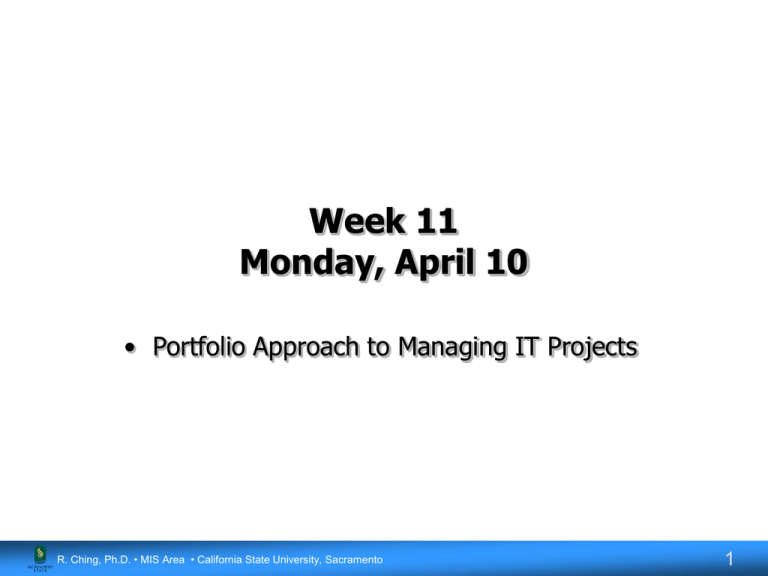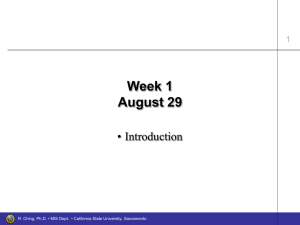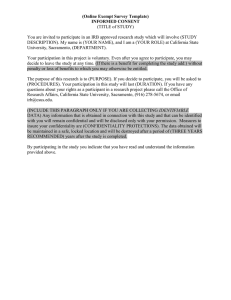Week 11 Monday, April 10 • Portfolio Approach to Managing IT Projects 1
advertisement

Week 11 Monday, April 10 • Portfolio Approach to Managing IT Projects R. Ching, Ph.D. • MIS Area • California State University, Sacramento 1 Profolio • Selecting and prioritizing projects – Which projects have the greatest impact? • Organization’s strategy • Internal processes – Which projects have the greatest risk? – Which projects have the greatest payoff? • In terms of dollars, tangible and intangible benefits – Which projects are required? – What is the value of information? R. Ching, Ph.D. • MIS Area • California State University, Sacramento 2 Portfolio Organization Strategic Plan IT Strategic Plan • Corporate infrastructure • IT infrastructure Corporate Initiatives Portfolio R. Ching, Ph.D. • MIS Area • California State University, Sacramento • Long-term projects • “Low-hanging fruit” Project Implementation 3 Project Risk • Serious deficiencies in IT management – Failure to assess the implementation risk of a project at the time it is funded – Failure to consider the aggregate implementation risk of the portfolio of projects – Failure to recognize that different projects require different managerial approaches Payoff Risk Potential The greater the risk, the greater the payoff (benefit) R. Ching, Ph.D. • MIS Area • California State University, Sacramento 4 Project Dimension and Risk • Project size – The larger the project (budget, staffing levels, duration, number of departments affected), the larger the risk • Experience with technology – Unfamiliarity with the technology (hardware, software, etc.) increases risk • Requirements volatility – Stable requirements reduce the risk; “evolving” projects pose greater risks R. Ching, Ph.D. • MIS Area • California State University, Sacramento 5 Effect of Increasing Risk Components Project Risk Project size Experience with technology Requirements volatility Risk Very High Risk High Risk Moderate Risk 1 2 Number of Risk Factors R. Ching, Ph.D. • MIS Area • California State University, Sacramento 3 6 Implementation Risk Categories Less Project Size High Requirements Volatility Low Technology High Technology Low Requirements Volatility Spreadsheet support for budgeting (low tech application, requirements unknown) Year 2000 compliance (low tech application, requirements known) Online graphic support for advertising copy (high tech application, requirements unknown) AI-driven bond trading (high tech application, requirements known) R. Ching, Ph.D. • MIS Area • California State University, Sacramento 7 Implementation Risk Categories Technology Low High Spreadsheet support for budgeting (low tech application, requirements unknown) Year 2000 compliance (low tech application, requirements known) Online graphic support for advertising copy (high tech application, requirements unknown) AI-driven bond trading (high tech application, requirements known) High Requirements Volatility R. Ching, Ph.D. • MIS Area • California State University, Sacramento Large Small Low 8 Dimensions Influencing Risk • Project size • Experience with technology • Requirements volatility (structured vs. unstructured) Small structured project with new technology “Low hanging fruit” Large, unstructured project with new technology Low Experience Large, structured project with known technology High Structured Large Project size Small Unstructured Requirements Volatility R. Ching, Ph.D. • MIS Area • California State University, Sacramento 9 Dimensions Influencing Risk • Project size • Experience with technology • Requirement volatility (structured vs. unstructured) Medium risk (structured, low experience, large project) Low risk (unstructured, high experience, small project) High Experience Low Structured Large Project size Small Unstructured Requirements Volatility R. Ching, Ph.D. • MIS Area • California State University, Sacramento 10 Dimensions Influencing Risk • Project size • Experience with technology • Requirement volatility (structured vs. unstructured) High risk (unstructured, low experience, small project) Very High risk (unstructured, low experience, large project) High Experience Low Structured Large Project size Small Unstructured Requirements Volatility R. Ching, Ph.D. • MIS Area • California State University, Sacramento 11 Risk Assessment Based on the Strategic Grid High Factory Operational IT Impact of Existing IT applications Support Basic elements Strategic Strategic IT plan, initiatives Turnaround Gradual adoption Low Low Impact of Future IT applications R. Ching, Ph.D. • MIS Area • California State University, Sacramento High 12 Risk Portfolio New core value Very high New benefits Improved benefits Variation Breakthrough systems Project Risk New platforms High Derivative systems Medium Low-hanging fruit Low Portfolio composed of different projects R. Ching, Ph.D. • MIS Area • California State University, Sacramento 13 Project Management: A Contingency Approach “There is no single correct approach to all projects” • Management tools – External integration – Link project team to system users – Internal integration – Ensure project team Use depends operates as an integrated unit on the – Formal planning – Structure sequence of project tasks, estimate time, money and resources – Formal result controls – Evaluate progress and flag potential problems R. Ching, Ph.D. • MIS Area • California State University, Sacramento 14 Implementation Risk Categories High Requirements Volatility Low Technology High Technology Low Requirements Volatility Low-risk profiles • External integration critical • Internal integration necessary • Formal planning tools, traditional • Results controls necessary Projects easy to manage • External integration necessary • Internal integration less necessary • Formal planning tools, traditional • Results controls necessary Extremely difficult and should not be taken lightly • External integration critical • Internal integration necessary • Formal planning tools, less predictive value (due to uncertainties) • Results controls necessary Projects not easy to manage • External integration not crucial • Internal integration crucial • Formal planning tools, less predictive value • Results controls limited, personnel monitoring important R. Ching, Ph.D. • MIS Area • California State University, Sacramento 15 Risk Management From Sprague and McNurlin • Types of risk – Technical – failure due to technology – Business – failure do due organizational issues • Assessment of risks – Project’s leadership – commitment, experience, abilities, formal and informal management skills – Employee’s perspective – acceptance to change – Scope and urgency – extent of change (breadth and depth), need to implement change R. Ching, Ph.D. • MIS Area • California State University, Sacramento 16 Risk Management Employees’ Perspective Leadership Likelihood of Business Recommended Project Scope Change Project Method and Urgency High Big Bang + + Guided Evolution + + + - R. Ching, Ph.D. • MIS Area • California State University, Sacramento Top-down Coordination - - Championed Dealmaker Championed Improvision + Champion Guided Evolution - Migrate or Kill the Project + Low More Risky - - Less Risky Improvisation - 17 Other Aspects of IT Project Management Based on a Survey of 10 Executives in Sacramento • Develop and compare feasibility, complexity, scalability and cost of possible solutions • Project portfolio – investing in the right projects • Aligning projects and initiatives to strategic objectives • Risk management – risk considerations, factors and plans – Contingency plans • Managing multiple vendors and workflow • Regulatory and compliance issues • Leveling resources over projects – human, financial, technical R. Ching, Ph.D. • MIS Area • California State University, Sacramento 18 Other Aspects of IT Project Management Based on a Survey of 10 Executives in Sacramento • Project planning, execution and scheduling – Prioritizing, defining performance measures, tracking processes to ensure performance, schedule resources, project monitoring, change and service controls, quality assurance and testing, identify key drivers • Project leadership – Assessing change and change management, communication and organizational skills • Adoption issues • Identify and understanding stakeholders R. Ching, Ph.D. • MIS Area • California State University, Sacramento 19 Good IT Project Management • • • • • • • • • • Deliver on time Successful project Come in or under budget characteristics Meet the original objectives Establish ground rules Foster discipline, planning, documentation and management Obtain and document the “final” user requirements Obtain tenders from all appropriate potential vendors Include suppliers in decision making Convert existing data Follow through after implementation R. Ching, Ph.D. • MIS Area • California State University, Sacramento 20 Value of a System or Application • Benefits the business will receive from the IT – IT by itself provides no benefits or advantages • Measuring benefits – Distinguish between the different roles of the systems – support role, integral to strategy, or product/service offering – Measure what is important to management – Assess investments across organizational levels R. Ching, Ph.D. • MIS Area • California State University, Sacramento 21 Measuring Benefits: Role of System • Measuring organizational performance – ability to support the organization and its users with their tasks • Measuring business value – help meeting organizational and business goals • Measuring a product or service – profitability of product or service R. Ching, Ph.D. • MIS Area • California State University, Sacramento 22 Measuring Benefits: Importance to Management • IT is usually not viewed as a revenue generator – Investment to improve the business • Corporate effectiveness • Less tangible benefits includes – Customer relations (satisfaction) – Employee morale – Time to complete an assignment R. Ching, Ph.D. • MIS Area • California State University, Sacramento 23 Measuring Benefits: Across the Organization Sources of Value • Potential benefits differ at various organizational levels • Dimensions – Economic performance payoffs (market measures of performance) – Organizational processes impact (measures of process change) – Technology impacts (impacts on key functionality) R. Ching, Ph.D. • MIS Area • California State University, Sacramento Assess IT’s impact in each cell 24 Value of IT Investments to Investors • Brynjolfsson, Hitt and Yang study – Every $1 of installed computer capital yielded up to $17 in stock market value, and no less than $5 – Led to organizational changes that created $16 worth of “intangible assets” – Past IT investments correlated with higher current market value R. Ching, Ph.D. • MIS Area • California State University, Sacramento 25 Value of IT Investments to Investors • Brynjolfsson and Hitt study – Organizational factors correlated to and complemented IT investments • Use of teams and related incentives • Individual decision-making authority • Investments in skills and education • Team-based initiatives – Businesses making the highest IT investments not only invest in IS but also invest in making organizational changes to complement the new IS R. Ching, Ph.D. • MIS Area • California State University, Sacramento 26 Value of IT Investments to Investors • Brynjolfsson and Hitt study (cont.) – Led to adoption of decentralized work practices • Frequent use of teams • Employees empowered (i.e., given broader decision-making authority) • Offer more employee training R. Ching, Ph.D. • MIS Area • California State University, Sacramento 27 Value of IT Investments to Investors • Brynjolfsson, Hitt and Yang study – Companies with the highest market valuation had the largest IT investments and decentralized work practices – Market value of investing in IT is substantially higher in businesses that use these decentralized practices because each dollar of IT investment is associated with more intangible assets because the IT investments complement the work practices Other resource IT Leveraging R. Ching, Ph.D. • MIS Area • California State University, Sacramento 28



